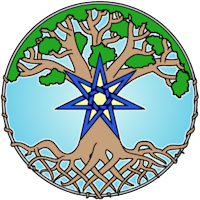So, yesterday someone asked me a question about what kind of books and resources I would recommend for getting started with magic. I inquired further, and they clarified that they had no interest in deities at this point, which narrowed down my potential list of recommendations. After a little poking through my shelves and some reviews for books I haven't gotten my hands on yet, I finally settled on these:
- Psychic Witch: A Metaphysical Guide to Meditation, Magick, and Manifestation, by Mat Auryn
I haven't read this one yet, but I have leafed through it and it seemed like it was pretty solid on the basics: meditation, energy work, grounding and shielding, etc. And it got a pretty glowing review from John Beckett! There's also a sequel of sorts: Mastering Magick: A Course in Spellcasting for the Psychic Witch. And you can find out what else Mat Auryn has been up (or find podcast episodes where he had a guest appearance to talk about his books) to on his website. - Grovedaughter Witchery: Practical Spellcraft, by Bree NicGarran
This one I own, and I've followed the author on social media for a decade or longer, and her stuff is usually pretty clear, and almost always secular. Despite being a pagan, the gods don't really figure in her witchcraft; her focus is more on folkloric-flavored witchcraft, inspired by fairytales. Bree also has a podcast, Hex Positive, which has a lot of additional resources. - Evolutionary Witchcraft, by T. Thorn Coyle
I own this one, too, and read it for the book club run by the Fellowship Beyond the Star a few years back. It's from a Feri/Reclaiming perspective, and does include some deities but it also includes both the Iron and Pearl Pentacles, and a lot of movement exercises, which makes it a valuable addition to this list. - TrancePortation: Learning to Navigate the Inner World, by Diana L. Paxson
This one is very focused on trancework and remains one of the most comprehensive books I've ever read on that topic. It's heavy though, so it takes a while to get through, but all the exercises build on each other. If you're interested in trancework and journeying, I can't recommend it enough. - Six Ways: Approaches and Entries for Practical Magic, by Aidan Wachter
I haven't read this one, either, but I did just finish Weaving Fate: Hypersigils, Changeing the Past, and Telling True Lies, by the same author and that book moved this one into my Need category. Weaving Fate is a little more specific and a little more advanced, but a very engaging and straightforward read with good instructions; I can't imagine Six Ways being much different in that regard. - Sigil Witchery: A Witch's Guide to Crafting Magick Symbols, by Laura Tempest Zakroff
This is the first that was recommended by someone else as I was discussing this post, and I was really grateful for the suggestion because my own sigils are almost always bindrunes or ogham or some combination thereof, so I don't really own any books on sigilry. It's a powerful type of magic in its own right though, and though it doesn't really jive with my personal practice (I don't use other people's sigils, as a rule), I have long been impressed with Tempest's work. Plus, this book had a glowing review from another author whose work I admire, Misha Magdalene (author of Outside the Charmed Circle: Exploring Gender and Sexuality in Magical Practice, a must-read for any queer neopagans or group leaders) - The Elements of Spellcrafting: 21 Keys to Successful Sorcery, by Jason Miller
I've seen this one recommended a lot, too, though I've yet to get my hands on a copy of it to leaf through. Still, I've found many of Jason Miller's blogs very insightful, and this book has a great review by another blogger I've long admired, River Enodian.
I think I'll stop there, for now - I could recommend more blogs and online courses and youtube channels but for now I think I'll stick to a list of books! I'd love to hear other people's suggestions as well - if you feel like I made a mistake leaving out your favorite book, let me know! Feel free to talk about them in the comments here or on FB; I always love to start a conversation. (And who knows, if this really becomes a conversation maybe I'll curate a list of other types of resources: podcasts and classes and videos, oh my!)
(And yes, those are affiliate links - no pressure obviously, but if you want to, you can check out my curated lists on Bookshop.org!)
